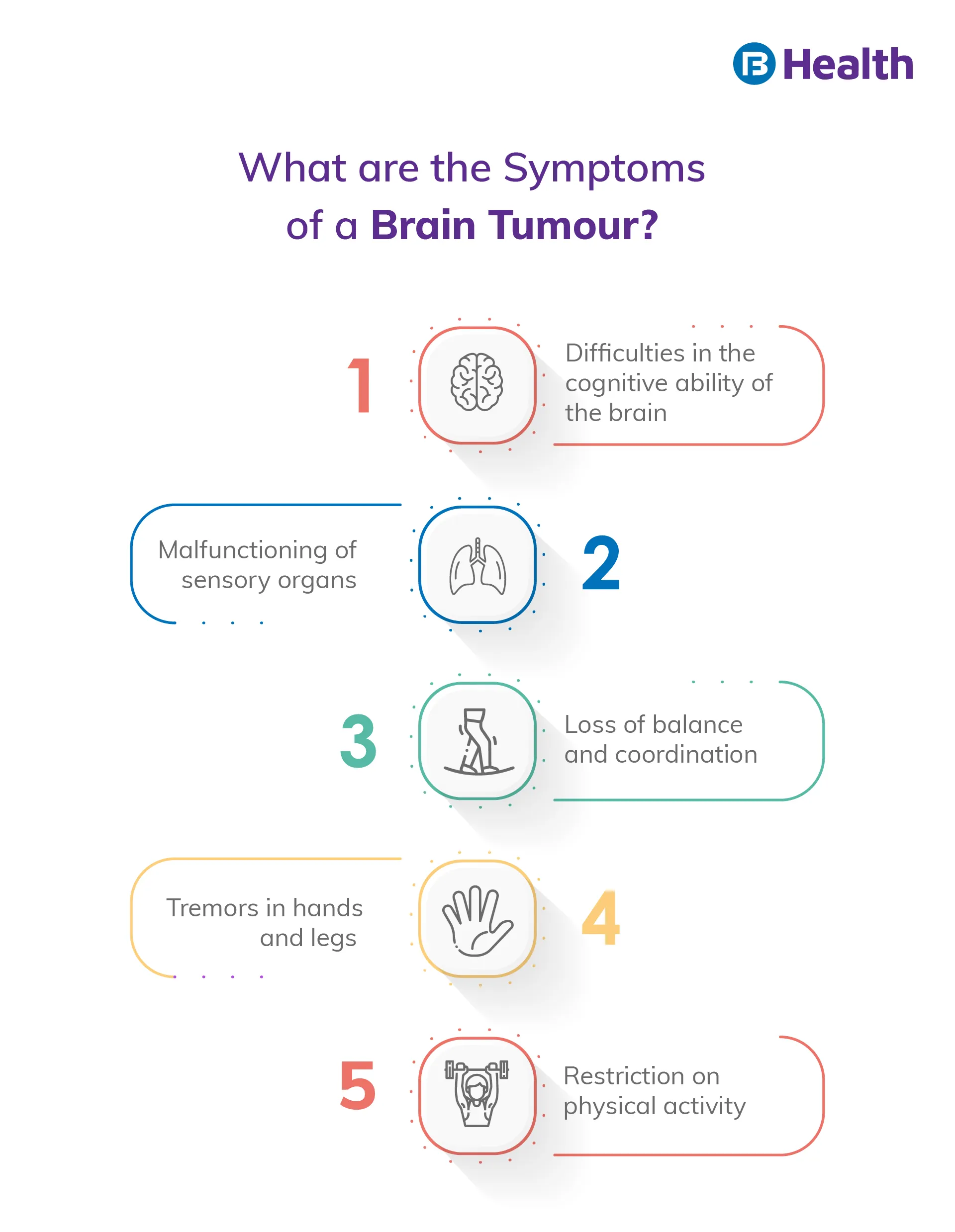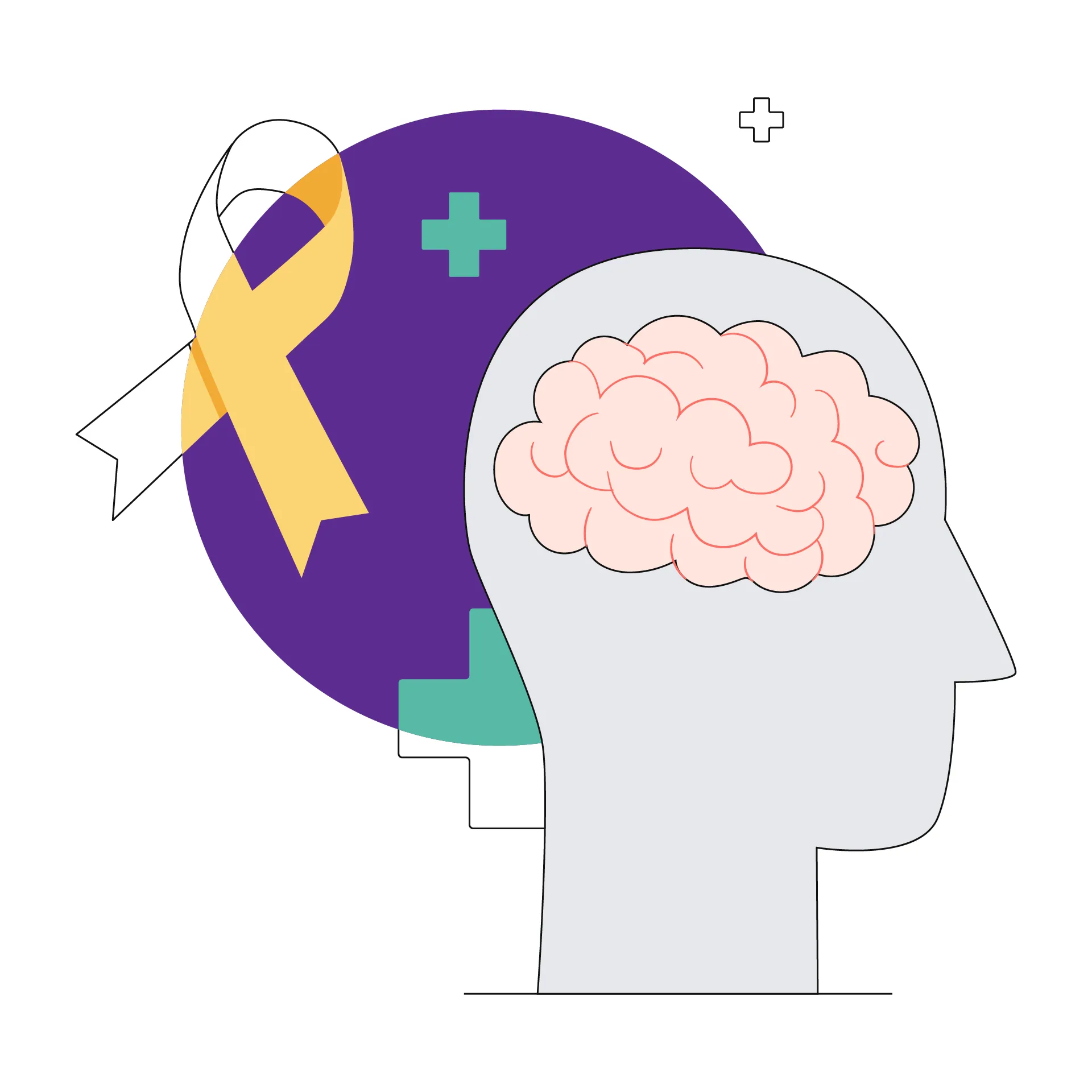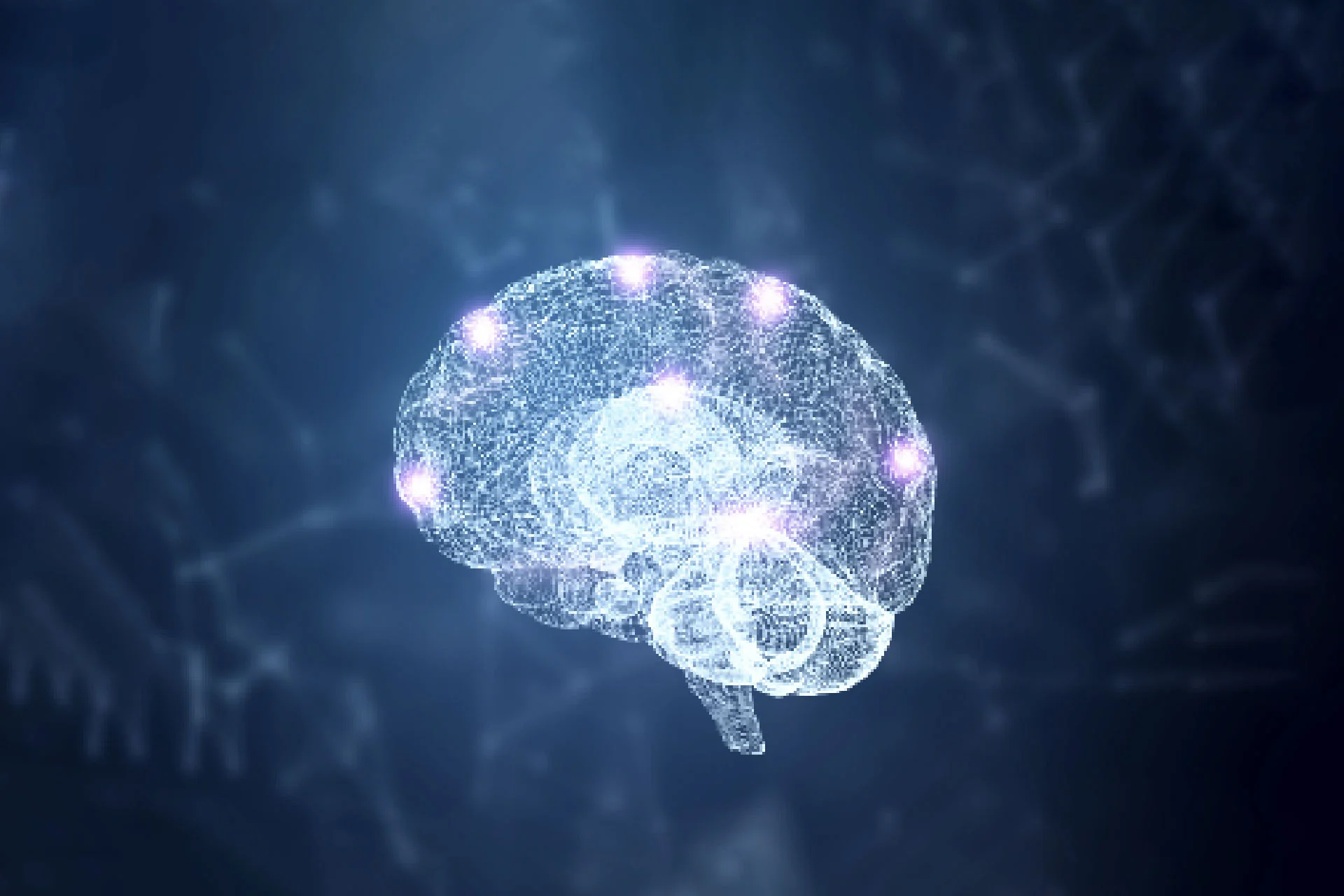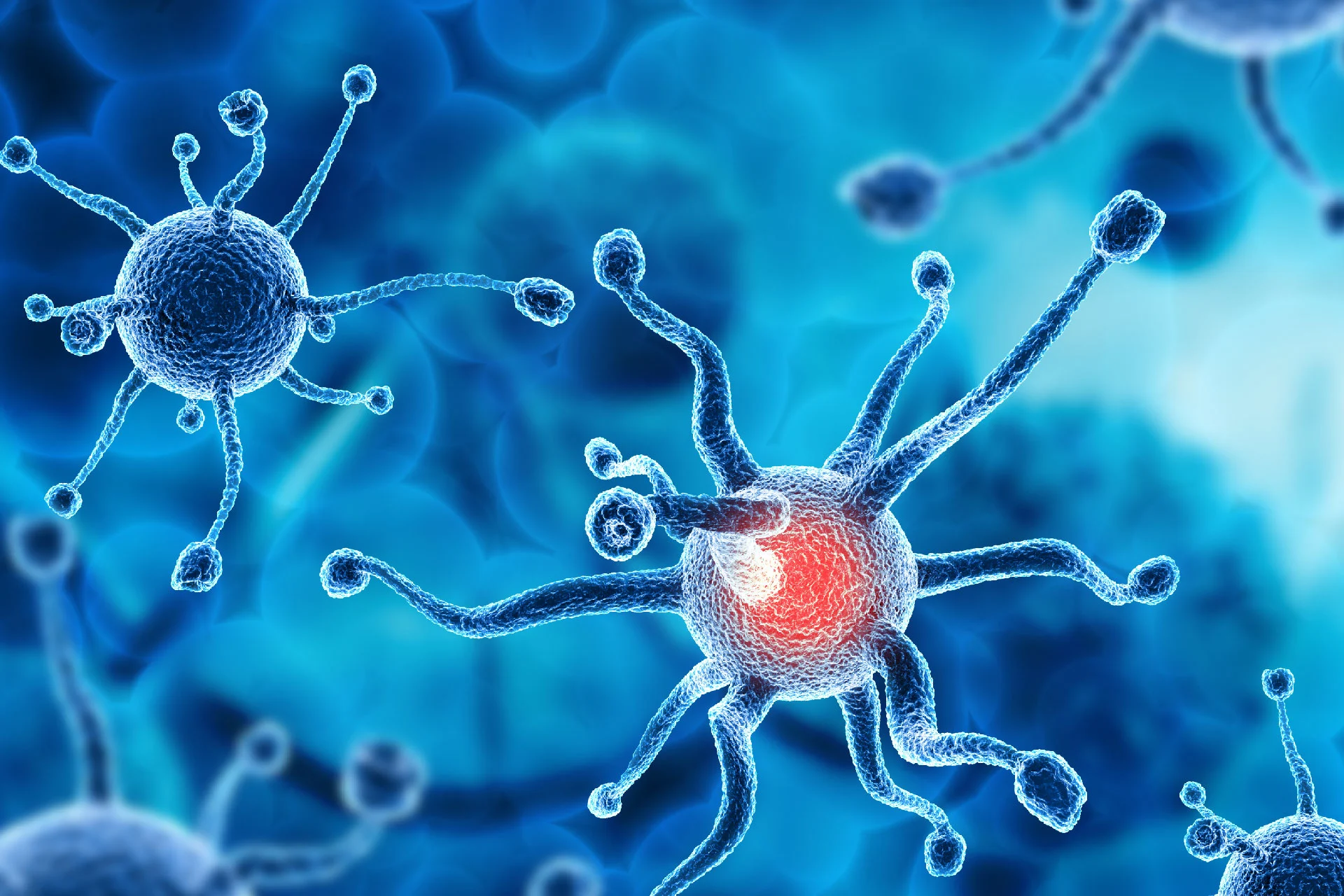Cancer | 8 min read
Brain Tumour: Means, Causes, Early Sign, Types
Medically reviewed by
Table of Content
Synopsis
Brain tumours get classified as malignant (cancerous) or benign (non-cancerous) and can affect adults and children. But whether they are cancerous or not, brain tumours can impact your brain function if they grow large enough to press on surrounding tissues.
Key Takeaways
- Brain tumours are masses formed when the cells in the brain develop abnormally
- The most common signs of a brain tumour are frequent, excruciating headaches
- Your nervous system's ability to function depends on the growth rate and location of a brain tumour
What is Brain Tumour?
A mass of aberrant brain cells is known as a brain tumour. Your skull, which protects your brain, is highly rigid. Any growth inside such a small region can pose issues.
Brain tumours can be cancerous or non-cancerous. If there is growth in benign or malignant tumours, the pressure inside your skull can rise. It can result in brain damage, and it can be lethal.
Brain tumours get classified as either primary or secondary:
- Your brain develops a primary brain tumour. Initial brain tumours generally provide no threat
- A secondary brain tumour, also known as a metastatic brain tumour, develops when cancer cells move from another organ, such as your lung or breast, to your brain
What Causes Brain Tumours?
Researchers know that brain tumours form when particular genes on a cell's chromosomes are damaged and do not function correctly, but they don't understand why this happens. Your DNA, contained in your chromosomes, instructs cells throughout your body on when to develop, divide/multiply, and die. [3]
When the DNA of your brain cells changes, it sends new instructions to your brain cells. Your body produces aberrant brain cells that grow and multiply faster than regular and live longer. When this occurs, an ever-increasing swarm of aberrant cells takes over space in your brain.
Environmental factors, such as X-ray radiation exposure or previous cancer treatment, may cause additional harm.
Additional Read: Endometrial Cancer
Brain Tumour Types
There are two types of brain tumours, i.e., Primary and Secondary.
Primary brain tumours
Primary brain cancers begin in the brain. They can form from your:
• Brain cells
• The membranes that surround your brain, known as meninges
• Nervous cells
• Glands such as the pituitary of the pineal
Primary tumours can be either benign or malignant. Meningiomas and Gliomas are the most predominant forms of brain tumours in grown-ups.
Gliomas
Gliomas are tumours formed by glial cells. These cells normally:
• Sustain the structure of your central nervous system
• Nourish your central nervous system
• Clear cellular debris
• Degrade dead neurons
Gliomas can arise from several types of glial cells.
• Astrocytic tumours, such as astrocytomas, which develop in the cerebrum
• Oligodendroglial tumours, which are generally found in the front temporal lobes
• Glioblastomas, which arise in supporting brain tissue and are the most aggressive form
Additional read: What is Esophageal Cancer?Other primary brain tumours
Other primary brain tumours include:
• Benign pituitary tumours
• Benign or malignant pineal gland tumours
• Benign ependymomas
• Craniopharyngiomas: Primarily found in youngsters and are benign. They can cause clinical symptoms such as visual abnormalities and premature puberty
• Malignant, prime central nervous system lymphomas
• Benign and malignant: Primary germ cell tumours of the brain
• Meningiomas, which arise from the meninges
• Schwannomas, which arise from Schwann cells, generate the protective covering of your nerves (myelin sheath)
According to one study, meningiomas are identified more frequently in women than men. [4]
Schwannomas affect both men and women equally. These tumours are generally harmless, but their size and placement can create issues. Cancerous meningiomas and schwannomas are uncommon but can be deadly.
Additional Read: Vulvar Cancer CausesSecondary brain tumours
The majority of brain tumours are secondary brain tumours. They begin in one place in the body and spread, or metastasis, to the brain. The following can extend to the brain:
• Kidney cancer
Secondary brain tumours are always cancerous. Benign tumours do not spread from one place in your body to another.
Brain Tumour Early Symptoms
Brain tumour symptoms vary depending on its size and location. Some brain tumour causes direct harm by penetrating brain tissue, while others cause pressure on the surrounding brain.
You will feelsigns of a brain tumour if a tumour is pressing on the tissue in your brain.
Headache is a common sign of a brain tumour. You may have headaches that:
• Are worst when you first wake up in the morning
• Occur while you sleep
• Are exacerbated by coughing, sneezing, or exertion
Additionally, you may also notice the following:
• Vomiting
• Distorted or double vision
• Confusion
• Seizures (specifically in adults) [1]
• Weakening of a portion of the face or limb
• A change in mental functioning
Complications of Brain Tumour
The brain is an essential organ. Brain tumour complications can have devastating effects or cause irreversible damage, resulting in physical disability, unconsciousness, or even death.
Some of the complications are: [2]
• Clumsiness
• Difficulties with writing or reading
• Changes in hearing, taste, or smell
• Sleepiness and loss of awareness
• Difficulty swallowing
• Dizziness or vertigo
• Visual problems, such as drooping eyelids and uneven pupils
• Uncontrollable movements
• Hand tremors
• Loss of balance
• Loss of bladder or bowel control
• Impassiveness on one side of the body
• Having understanding issues with what others are saying
• Changes in emotions, personality, mood, and behaviour
• Difficulties in walking
Symptoms of Pituitary Tumours
Pituitary tumours can cause the following symptoms:
• Nipple discharge, also known as galactorrhea
• Lack of menstruation in women
• Development of breast tissue in men, also known as gynecomastia
• Enlargement of the hands and feet
• Sensitivity to heat or cold
• Hirsutism (excessive body hair)
• Low blood pressure
• Obesity
• Alterations in vision, such as fuzzy vision or tunnel vision
Additional Read: Prostate Cancer Symptoms
How are Brain Tumours Diagnosed?
A physical exam and your medical history are used to diagnose a brain tumour. The physical examination involves a thorough neurological examination. Your doctor will examine your cranial nerves to see if they are still intact. These nerves emerge from your brain, and an ophthalmoscope beams light through your pupils and retinas to examine the eyes. It enables your doctor to examine how your pupils respond to light. It also allows your doctor to see straight into your eyes to see if there is swelling in the optic nerve. This is because the optic nerve may change due to increased intracranial pressure.
The doctor may also assess your:
- Muscle strength
- Coordination
- Memory
- Ability to perform mathematical computations
After the physical exam, your doctor may prescribe additional testing. These may include:
The head's CT scan:
Your doctor can scan your body more thoroughly using a CT scan than with an X-ray scanner. Either contrast or no contrast can be used during this examination. A specific dye is used to achieve contrast during a CT scan, which enables medical professionals to view some structures, such as blood arteries.
MRI of the brain:
Your doctor may employ a specialized dye during a head MRI to aid in the detection of cancers. Because it doesn't involve radiation, an MRI differs from a CT scan and typically produces considerably more detailed images of the actual structures of the brain.
Angiography:
A dye gets injected into your artery during this procedure, typically in the groin area. Your brain's arteries receive it. Your doctor can use it to see how the tumour’s blood supply looks. When the surgery is taking place, this information is helpful.
Skull X-rays:
Specific X-rays can reveal if there have been any fractures or breaks in the skull's bones due to brain tumours. These X-rays can detect calcium deposits, which can get traced inside tumours.
Biopsy:
During a biopsy, a little bit of the tumour gets removed. It will get examined by a specialist known as a neuropathologist. The biopsy will identify if the tumour cells are benign or malignant. Additionally, it will reveal if cancer began in your brain or another area of your body.
Treatment of Brain Tumours
The following factors affect how a brain tumour gets treated:
- The type of tumour
- Its size
- Location
- Your general health
Surgery is the most common treatment for cancerous brain tumours. The objective is to eliminate as much cancer as possible without harming the brain's healthy areas.
While some tumours can get safely removed due to their position, others may be able to remove partially due to their location. The treatment needs to begin as soon as signs of a brain tumourstarted appearing.
Brain surgery has risks, such as bleeding and infection. Surgery is helpful to clear benign tumours that are clinically threatening. Treatment for metastatic brain tumours follows recommendations for the initial cancer type.
Chemotherapy and radiation therapy are two examples of additional brain tumour treatments that can get coupled with surgery.
You can recover from neurosurgery with the aid of physical therapy, occupational therapy, and speech therapy.
Undoubtedly, a brain tumour is fatal because your brain regulates every bodily function. The only way to stop a brain tumour from becoming life-threatening is to undergo routine screenings. If you're concerned about locating a qualified medical professional who can provide you with all the information you require, go no further than Bajaj Finserv Health. The expert professionals not only help you get information on a brain tumour, but you can also know about other forms of cancers, such as prostate, oesophagal, vulvar cancer, endometrial, etc. Here, you may schedule an appointment and refer to a professional in person or online consultation at your convenience. In addition, the app allows you to connect with the top medical professionals for oncologist consultation in your area. It also offers discounts and promotions at a few chosen partner businesses.
Your cancer specialist can advise you on the best course for managing any brain cancer symptoms you may develop and avoid consequences.
References
- https://www.cancer.org/cancer/brain-spinal-cord-tumours-adults/detection-diagnosis-staging/signs-and-symptoms.html
- https://www.cancer.org/cancer/brain-spinal-cord-tumours-adults/causes-risks-prevention/risk-factors.html
- https://www.ncbi.nlm.nih.gov/pmc/articles/PMC2761018/
- https://pubmed.ncbi.nlm.nih.gov/21823995/
Disclaimer
Please note that this article is solely meant for informational purposes and Bajaj Finserv Health Limited (“BFHL”) does not shoulder any responsibility of the views/advice/information expressed/given by the writer/reviewer/originator. This article should not be considered as a substitute for any medical advice, diagnosis or treatment. Always consult with your trusted physician/qualified healthcare professional to evaluate your medical condition. The above article has been reviewed by a qualified doctor and BFHL is not responsible for any damages for any information or services provided by any third party.





